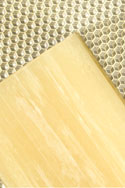
Photo © Steven Foster
Introduction
Beeswax is synthesized by wax-secreting glands on the underside of worker honeybee (Apis mellifica) abdomens through conversion of floral sugars,1 and is used by the bees to build honeycomb. Yellow beeswax (cera flava) is the crude form; when bleached by the combined action of sunlight, air, and moisture (or peroxides) it becomes white beeswax (cera alba).2 Beeswax absolute is derived from yellow beeswax by extraction with alcohol.2 Containing over 300 different substances, beeswax is an extremely complex material.3 History and Cultural Significance
Beeswax has a long history of use in lamps for illumination, and in providing raw material for candles and votive lights.1 The Aborigines of Northern Australia have used beeswax to sculpt wax figures used in religious ceremonies. Beeswax was used in casting metals prior to the Bronze Age (ca. 3300-1200 BCE). It has been used in commerce and business in the form of wax seals for documents. One interesting use of beeswax is in the decorative Southeast Asian cloth dying process known as batik.1 In ancient Egypt beeswax was utilized as one of the main components of balms for mummification.4 Chinese traditional medicine makes use of beeswax as a treatment for diarrhea and hiccups and to relieve pain.2,5 Currently beeswax is used as a thickener, emulsifier, or stiffening agent in ointments, bath preparations, cold creams, emollient creams, make-up, lotions, lipsticks, hair dressings and conditioners, and other cosmetic products.2 It is also an ingredient in furniture polish.2,5 Modern Research
Scientists are studying the potential uses of polycosanols, which are compounds derived from beeswax that have been used extensively in South America and the Caribbean.6 Future Outlook
Currently the main quality issues with beeswax are adulteration and toxic contamination.3 The main contaminants are chemicals used in beekeeping, while environmental contaminants may play a smaller role. Contaminants found in beeswax include chemicals used to control mites and wax moths and wood protectants. Using alternatives for mite control and physical measures or non-toxic chemicals to protect the wax from wax moths may help to prevent contamination.3 References
1 Non-timber forest products- Non-timber forest products program at Virginia Tech in collaboration with USDA Forest Service. Fact sheet no 1. Available at: www.sfp.forprod.vt.edu/factsheets/beeswax.pdf. Accessed November 23, 2004. 2 Leung A, Foster S. Encyclopedia of Common Natural Ingredients. 2nd ed. New York: John Wiley & Sons, Inc.; 1996. 3 Bogdanov S. Quality and Standards of Pollen and Beeswax. APIACTA. 2004:38;334-341. Available at: www.apimondia.org/apiacta/articles/2003/bogdanov-1.pdf. Accessed November 23, 2004. 4 Tchapla A, Mejanelle P, Bleton J, Goursaud S. Characterisation of embalming materials of a mummy of the Ptolemaic era. Comparison with balms from mummies of different eras. Journal of Separation Science. 2004:27(3);217-234. 5 Jellin J, Gregory P, Batz F, Hitchens K, et al. Natural Medicines Comprehensive Database. 5th ed. Stockton, CA: Therapeutic Research Faculty; 2003. 6 Yuan C, Bieber E. Textbook of Complementary and Alternative Medicine. Boca Raton, FL: Parthenon Publishing; 2003.
|